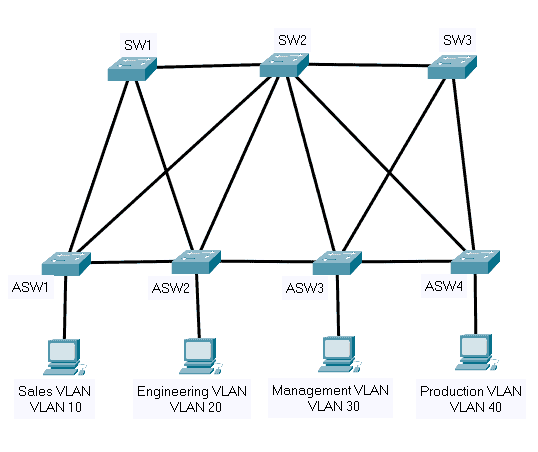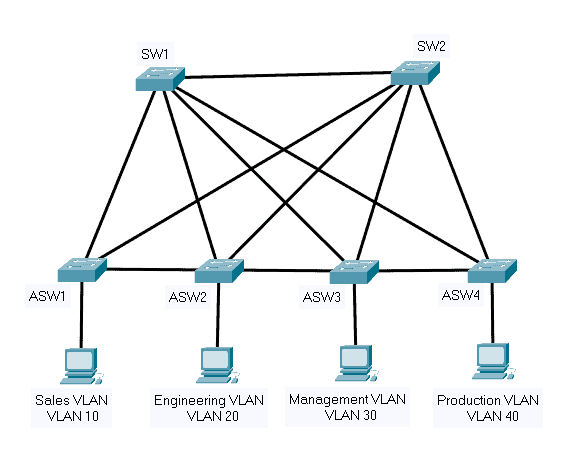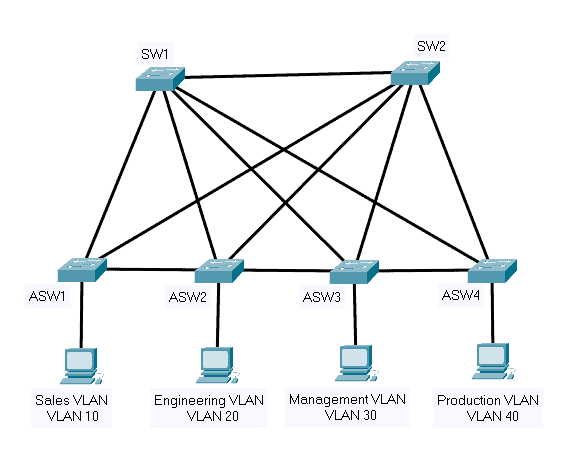STP, Spanning Tree Protocol, is enabled on all of the vendors’ switches by default. We have different Spanning Tree modes, both for Cisco proprietary and for open standard STP.
IEEE Open Standard Spanning Tree Modes
We have the following IEEE STP standards, which are used by all other vendors:
Spanning Tree Protocol (STP) IEEE 802.1D – the first and original implementation of the Spanning Tree Protocol standard. A single instance of spanning tree is allowed in the Local Area Network (LAN).
Rapid Spanning Tree Protocol (RSTP) IEEE 802.1w – improved version of 802.1D STP. It is faster for the network to converge. However, just like 802.1D STP, only a single instance of spanning tree is allowed in the Local Area Network (LAN).
Multiple Spanning Tree Protocol (MSTP) IEEE 802.1s – allows us to create multiple separate spanning-tree instances, and it enables us to map and allocate multiple VLANs to the instances.
Cisco Spanning Tree Modes
We have the following Cisco proprietary STP standards which are exclusively used by Cisco switches:
Per VLAN Spanning Tree Plus (PVST+) Protocol – Cisco-proprietary enhancement to the IEEE 802.1D STP, and it is the default spanning-tree version for Cisco switches. It enables us to create one instance of spanning-tree per VLAN.
Rapid Per VLAN Spanning Tree Plus (RPVST+) Protocol – Cisco-proprietary enhancement to the IEEE 802.1w RSTP. Similar to PVST+, it enables us to create a one spanning-tree instance per VLAN as well. Network convergence is also faster with RPVST+.
Single Spanning Tree vs Multiple Spanning Trees
With IEEE 802.1D STP and 802.1w RSTP standards, all of the VLANs will have one spanning-tree instance. Therefore, some will be taking suboptimal paths just like in the example topology below:
Since it is a single spanning-tree instance, there will be a single root bridge for all of the VLANs in the LAN. In this example, let’s say it’s SW1. All of the traffic will then be forwarded to SW1.
Our multiple spanning-tree modes, IEEE 802.1s MSTP, PVST+, and RPVST+, allow us to have various spanning-tree instances. These instances can take different paths through the network by having different root bridges, enabling load balancing to be possible. The traffic will be taking optimized paths for the same reason as well.
Multiple Spanning Tree Protocol (MSTP) Example
With the MSTP spanning-tree mode, we have one instance of spanning tree for each group of VLANs. Let’s say we have the following different departments in our office which are assigned with different VLANs:
- Sales Department – VLAN 10
- Engineering Department – VLAN 20
- Management Department – VLAN 30
- Production Department – VLAN 40
We can map the Sales and the Management departments to SW1 as their root bridge. For the Engineering and the Production departments, we can make SW2 their root bridge. Now, we have two instances of spanning tree running.
For the first instance, the traffic for VLAN 10 and VLAN 30 will be forwarded to SW1, and the links to SW2 will be blocked. In the second instance, the traffic for VLAN 20 and VLAN 40 will be forwarded to SW2 and will be blocked on SW1.
PVST+ and RPVST+ Example
PVST+ and RPVST+ Cisco spanning-tree modes are both Per VLAN spanning tree protocols. This means that every VLAN has a single instance of spanning tree. We’ll use this example topology again:
For example, we want the traffic from the Sales and the Management departments to be forwarded to their root bridge at SW2 and blocked on SW1. Also, the traffic from the Engineering and the Production departments will be forwarded to their root bridge at SW1, and SW2 will be in a blocked state.
There will be a total of four spanning-tree instances running, as we have four VLANs in the network. Assuming that we have 100 VLANs in our network, we will also have 100 spanning-tree instances. It would be consuming more resources as compared to grouping them like in MSTP.
PVST+ uses Root ports, Designated ports, and Alternate ports.
The Alternate Ports are Blocking Ports
The spanning-tree mode Command
We use the spanning-tree mode command to show the supported spanning-tree modes and to select the mode to use for the spanning tree configuration:
Switch(config)# spanning-tree mode ? mst Multiple spanning tree mode pvst Per-Vlan spanning tree mode rapid-pvst Per-Vlan rapid spanning tree mode
Download our Free CCNA Study Guide PDF for complete notes on all the CCNA 200-301 exam topics in one book.
We recommend the Cisco CCNA Gold Bootcamp as your main CCNA training course. It’s the highest rated Cisco course online with an average rating of 4.8 from over 30,000 public reviews and is the gold standard in CCNA training:



